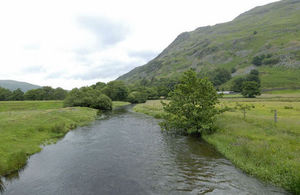New environmental scheme for farmers to prioritise biodiversity
Improving biodiversity and water quality will be prioritised in the new environmental land management scheme as part of the Common Agricultural Policy.

A river runs through fields
Farming Minister George Eustice announced today that the new environmental land management scheme will provide funding for farmers and land managers who deliver benefits for wildlife, improve water quality and create woodland.
Mr Eustice said:
We have a great track record in countryside stewardship schemes and we want to build on what has been started. The new scheme will prioritise promoting biodiversity and will be tailored to fit local needs. It will be more targeted so we can deliver wildlife corridors but there will also be grants available to all farmers.
From 2016, the new environmental land management scheme will be targeted so that farmers can help deliver environmental priorities specifically related to their local area, focussing particularly on increasing biodiversity, helping wildlife and improving water quality. For example, if one area is home to rare farmland birds, farmers will be reimbursed for enhancing this habitat. If, in another area, agricultural pollution has affected local rivers, farmers will be able to apply for funding to reduce soil erosion and run-off from their fields.
The existing Environmental Stewardship and England Woodland Grant Scheme will be brought together into a universal scheme that will be open to applications from both farmers and foresters.
During EU negotiations on the Common Agricultural Policy, the UK pressed for each country to have the option to channel a greater proportion of CAP funding into delivering environmental benefits. As a result, £3.1billion of funding will be available for environmental schemes in England which is a higher proportion of the CAP budget than ever before.
Plans for England’s implementation of the EU’s Young Farmers Scheme to give extra support to farmers under forty years of age were also set out today. Defra has announced the intention to apply this support to the maximum land area of farms. Young farmers will be able to claim a top-up payment for up to ninety hectares of their holding for the first five years of its operation.
The work of farmers and land managers through existing agri-environment schemes has created habitats for rare farmland birds and pollinators and boosted rural tourism by improving the natural environment. Since 2005, they have:
- managed 41% of English hedgerows, providing shelter and food for wildlife
- restored or newly planted 30,000 kilometres of hedgerows
- helped pollinators by sowing wildflowers in arable field margins
- helped increase breeding populations of nationally scarce farmland birds including the cirl bunting (increased by 600% since 1989) and stone curlew
Nearly 52,000 farmers and other land managers have signed up for the schemes, covering over 6.4 million hectares - or 70% of farmland in England.
The full CAP consultation response is available.
A new timeline showing key milestones in the countdown to the new CAP has been published.